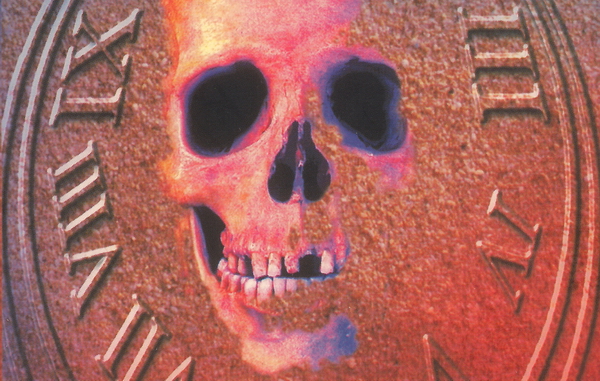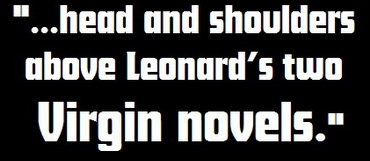|
| |
|
STORY PLACEMENT THIS STORY TAKES PLACE BETWEEN THE NOVELS "THE BODY- SNATCHERS" AND "WAR OF THE DALEKS."
WRITTEN BY PAUL LEONARD
RECOMMENDED PURCHASE OFFICIAL BBC 'EIGHTH DOCTOR' PAPERBACK (ISBN 0-563-40572-4) RELEASED IN SEPTEMBER 1997.
BLURB Years after leaving UNIT, Jo receives a plea for help from
an old acquaintance... Doctor and Sam visit Earth in 2109 - but there is no trace of the human race. Earth is home of the Tractites, a peaceful race who have been living there for thousands of years. Astronished and appalled, the Doctor travels back in time to see just what went wrong in Earth's
prehistory. expedition been taken back in time? Are the Tractites all they seem?
separated from the TARDIS, the Doctor's last chance to put things right rests with Sam - but has even she turned against him? |
|
|
Genocide SEPTEMBER 1997
Just when I was starting to think that I wasn’t a Paul Leonard man, his first cont- ribbution to the BBC Books range, Genocide, came along and managed to fuse the most successful facets of his Virgin novels together whilst trimming away the preponderance of the fat. The result is a wacky, warped and often quite wonderful tale that puts both Venusian Lullaby and Speed of Flight to shame.
The main plot of the novel is thus: it is the year 2109 and humanity is extinct. The Earth, now rechristened Paratractis, is inhabited by a peace-loving race called the Tractites. There is no sign that humanity ever existed. As the story progresses, we learn that the Earth Empire annihilated the Tractites in the future, causing some rancorous Tractite survivors to travel back in time millions of years and wipe out mankind before it evolved. The problem is, the new timeline is not stable and is in danger of destroying the whole multiverse. That’s right – not just the universe that the Doctor knows and loves, but all the countless billions of parallel universes too.
This allows Leonard to portray the new Doctor in a very ‘seventh Doctor’ sort of way. His duty to the ‘proper’ timeline clear, the Doctor is resolved to putting history back on its right course and restoring the human race, in effect wiping out the Tractites. However, taking on the mantle of ‘Uncreator’ is not quite as easy for Eight as it was for his predecessor; indeed, he can even be seen to shed a tear from his ‘human eyes’ here.
It’s also quite difficult for the reader to swallow too, particularly when juxtaposed with Sam’s misguided attitude towards the situation. In this novel the Doctor’s mutinous companion comes close to wiping out the human race because she thinks that the Tractites have a greater claim to survival than her own people; she even allows Kitig, a Tractite, to board he TARDIS when his world is obliterated. This leads to some fantastic scenes of tension between the Doctor and Sam but, more importantly, it really makes the reader think. Does the human race automatically deserve to survive because its timeline came first, before the Tractites overwrote it?
the corrupt UNIT officer, Jacob Hynes. Whilst on the surface his plan to do away with humanity and replace it with the Tractites is reprehensible, is it really that far away from, say, what Mike Yates tried to pull off in Invasion of the Dinosaurs? Is it really such a heinous goal? Of course the answer is a resounding ‘yes’, but through Sam we are forced to look at the matter from a different perspective. Arguably, this novel would have been much more interesting had Hynes not been portrayed as being so thoroughly evil. Particularly in his early scenes with Rowenna, the man is a monster; a fact made all the more chilling by his wearing of a UNIT uniform. However, had Hynes been portrayed as more of a shade of grey – just as Mike Yates was in Invasion of the Dinosaurs – then I think the central dilemma of the story would have been much more gripping.
Genocide is also notable for the heralding the return of Jo Grant, last seen on television in the third Doctor serial The Green Death back in the summer of 1973. Leonard’s Jo is much older, wiser and cynical than she once was. Her husband Cliff has long since left her, and she now struggles to raise their son, Matthew, alone. In the first half of the novel, I love what Leonard does with Jo. It’s absolutely fascinating to see her all grown up and leading her own life, but even more so to see her by the Doctor’s side once more. Only now, she won’t take any of his shit.
Sadly, Jo’s inclusion feels a bit superfluous; Genocide hardly needs her, save for her being the latest in a long line of gimmicks. Eight Doctors. UNIT. Litefoot and the Zygons. Jo Grant. Every once in a while, a nice little nod to the past or even the return of an old foe and/or companion is a wonderful indulgence, but every single month? Talk about overkill. Worse still, the story’s finale is entirely at odds with Jo’s character. She may have grown up and become rather bitter, but there is a distinct difference between standing up for herself when the Doctor patronises her and carrying out a massacre.
Finally, those who appreciated Venusian Lullaby with its vivid descriptions of alien life will no doubt appreciate Leonard’s latest creations - the Tractites. They are, crudely put, ‘four-eyed horses with arms’. In this novel Leonard may not have gone quite as far with his world building, but nevertheless Genocide is still replete with a truly extraordinary level of detail.
For me though, the difference between this book, which I liked, and Venusian Lullaby, which I didn’t, is that as alien as the Tractites are, I could relate to them. Leonard’s characterisation is now every bit as impressive as his descriptive prose. Take Kitig - a remarkably amiable, reasonable and noble creature for what is, essentially, a talking horse!
And so whilst
Genocide is far from perfect, it is head and shoulders above Leonard’s
two Virgin novels. There is so much about it that is good, even the most
severe of my gripes can quite easily be brushed aside. A recommend read.
|
|
|
Copyright © E.G. Wolverson 2010
E.G. Wolverson has asserted his right under the Copyright, Designs and Patents Act, 1988 to be identified as the author of this work. |
|
|
When we meet Jo in the The Sarah Jane Adventures, she is still married to Clifford, with whom she has had seven children and innumerable grandchildren. She doesn’t recall having encountered the Doctor since they said goodbye. A number of later releases from Big Finish also reinforced the notion that Jo and Clifford lived happily ever after.
However, this novel saw the eighth Doctor encounter Jo and (what was assumed was) her only son following a divorce from Clifford. One could surmise that these events have yet to happen for Jo, in which case the Doctor would have to keep schtum about them in The Sarah Jane Adventures, but thanks to Faction Paradox Eight’s biodata is riddled with inconsistencies that could easily account for an anomalous adventure in print. Indeed, this latter option seems more likely given that Genocide appears to be set in the late 1990s.
|
|
|
Unless otherwise stated, all images on this site are copyrighted to the BBC and are used solely for promotional purposes. ‘Doctor Who’ is copyright © by the BBC. No copyright infringement is intended. |
|

.jpg)
.jpg)

 This issue is
explored further through
This issue is
explored further through